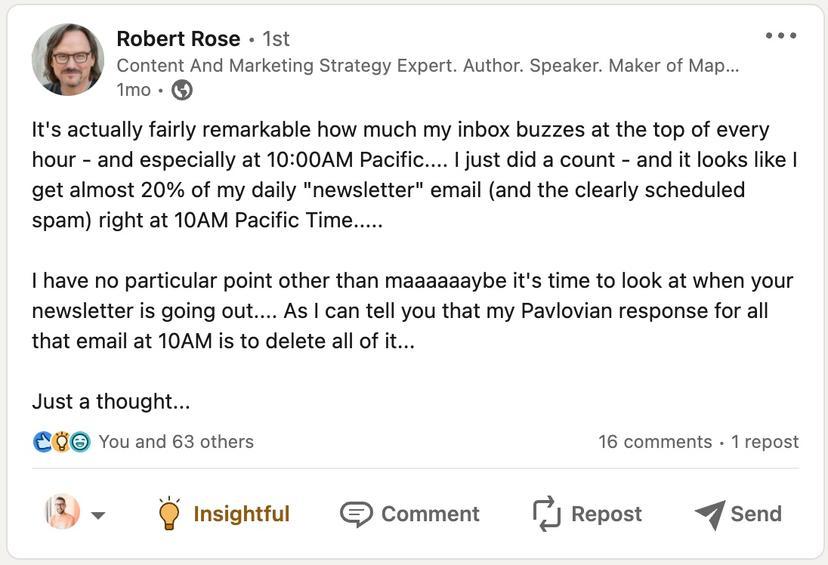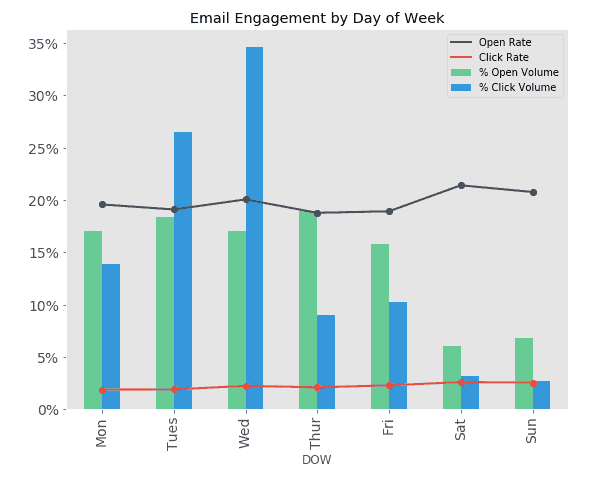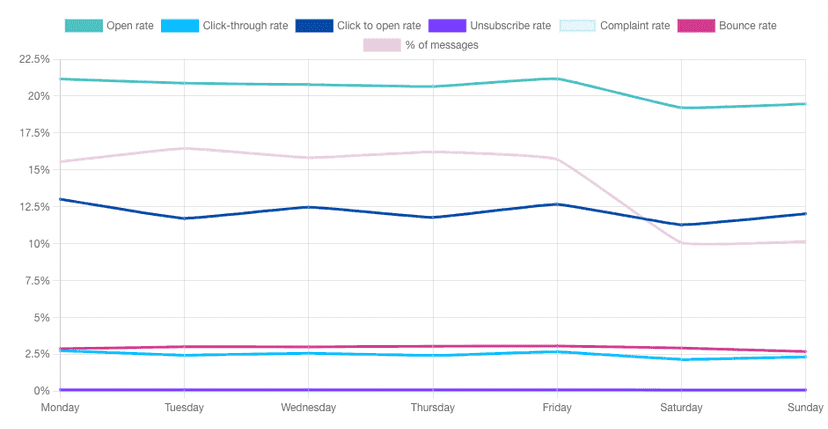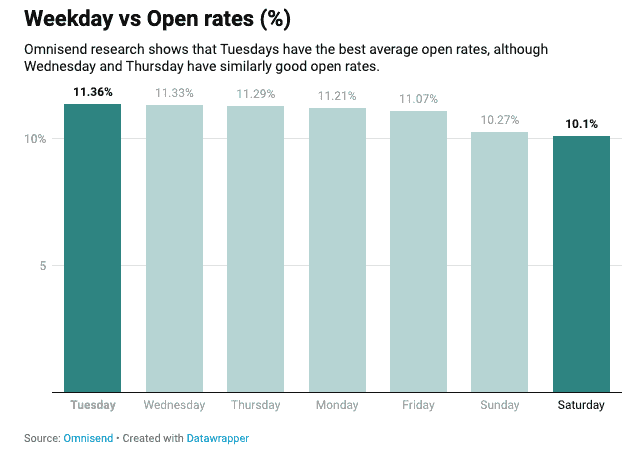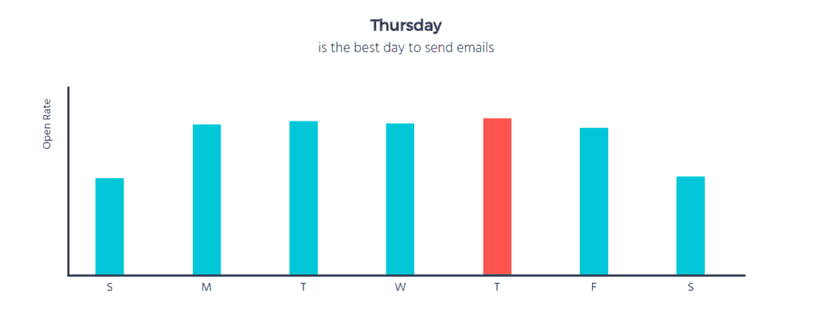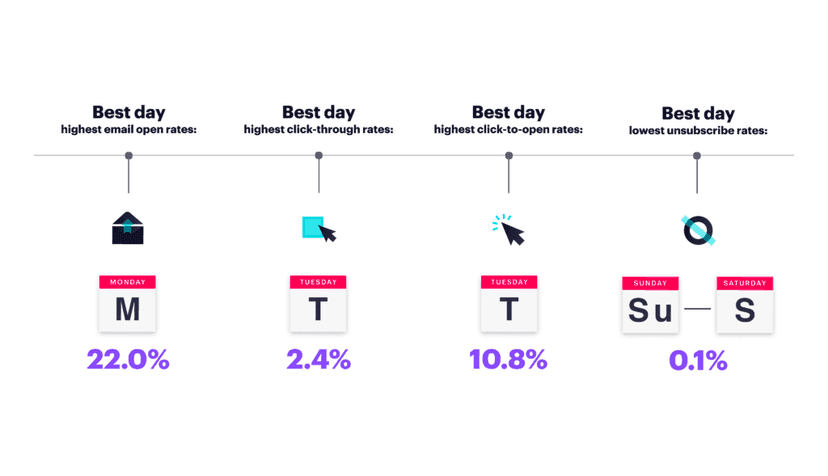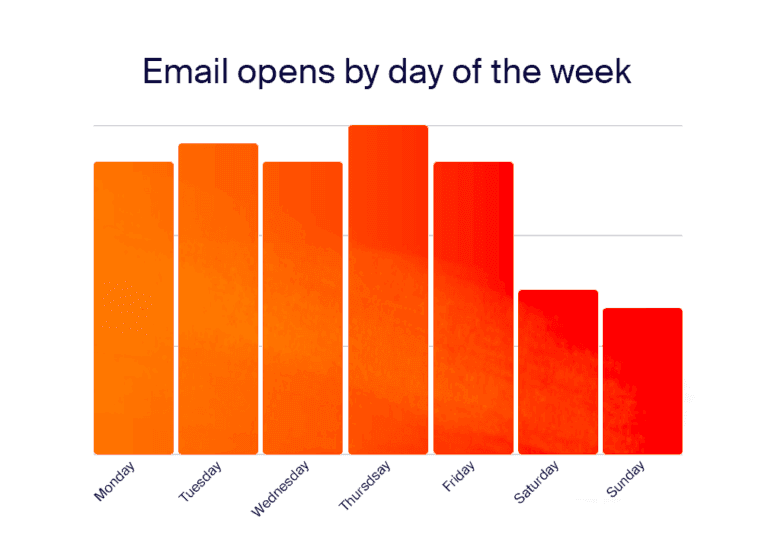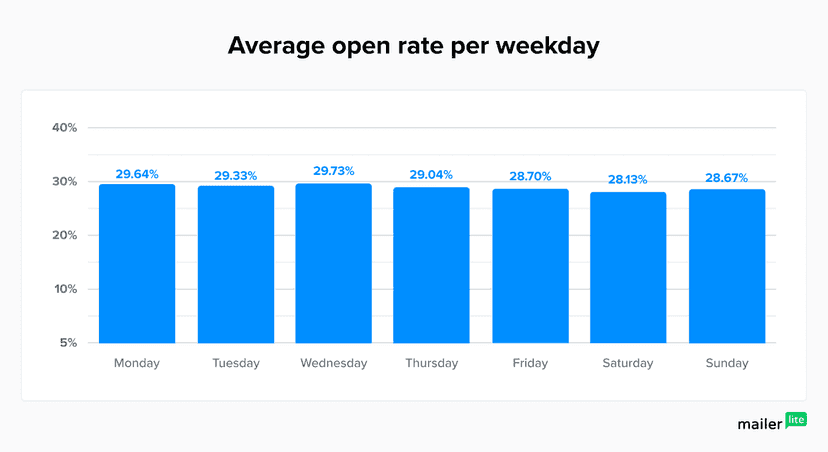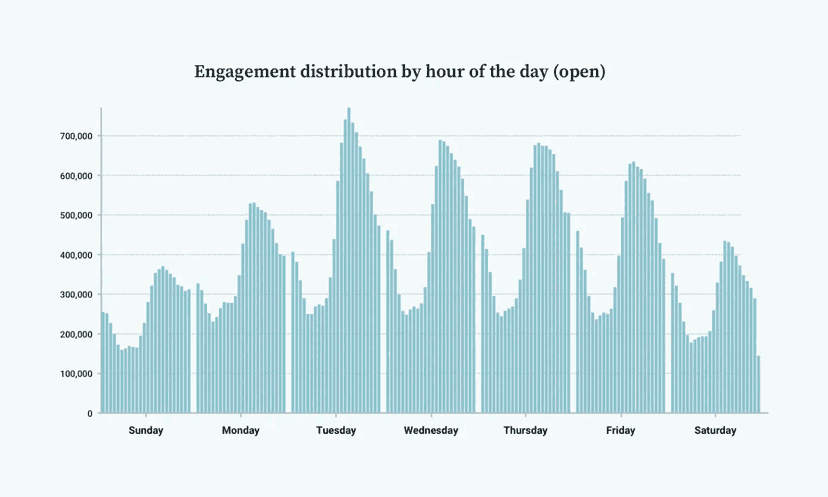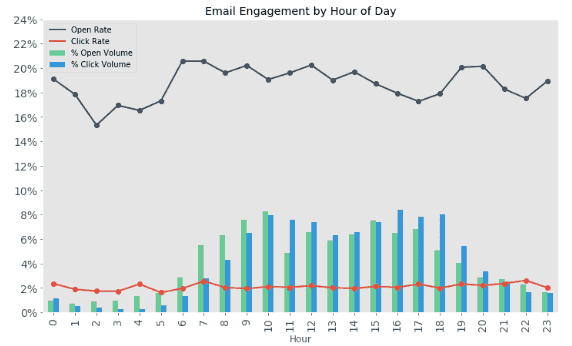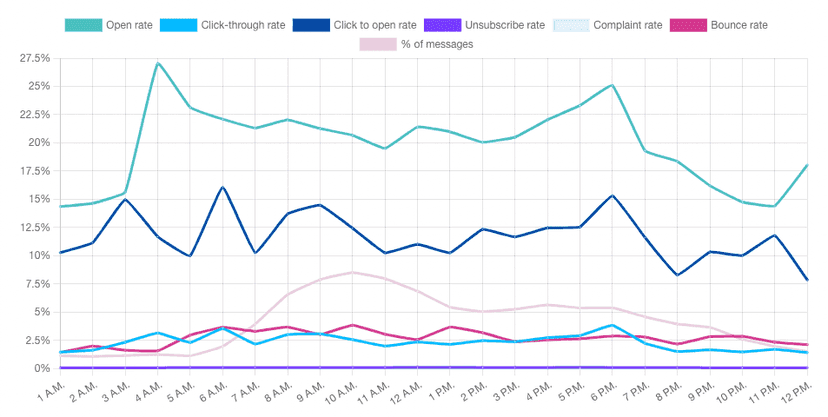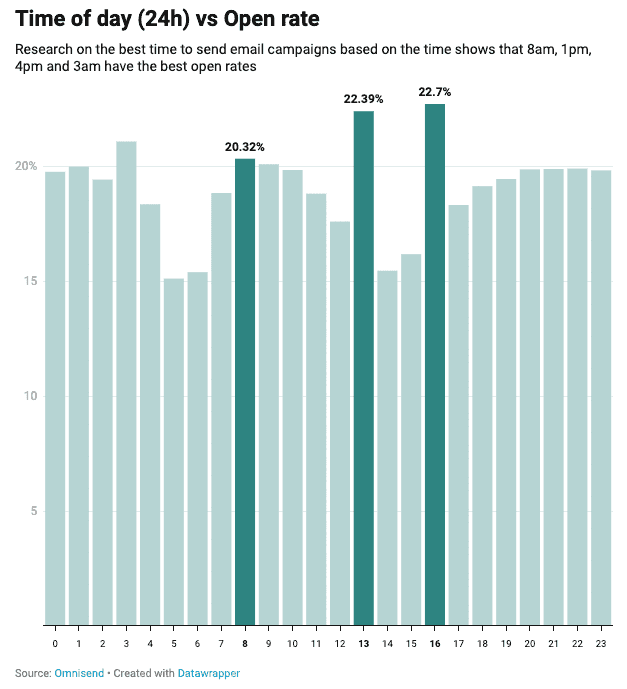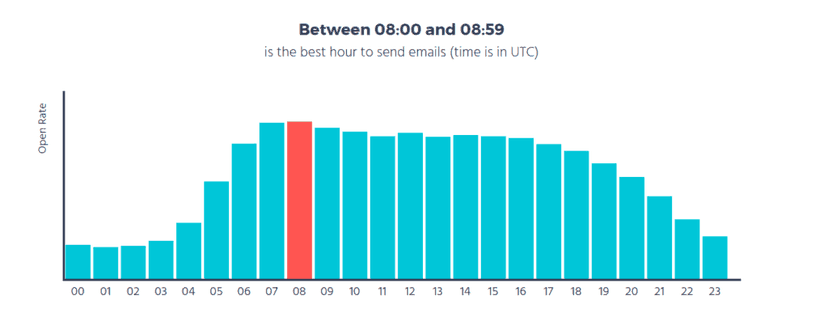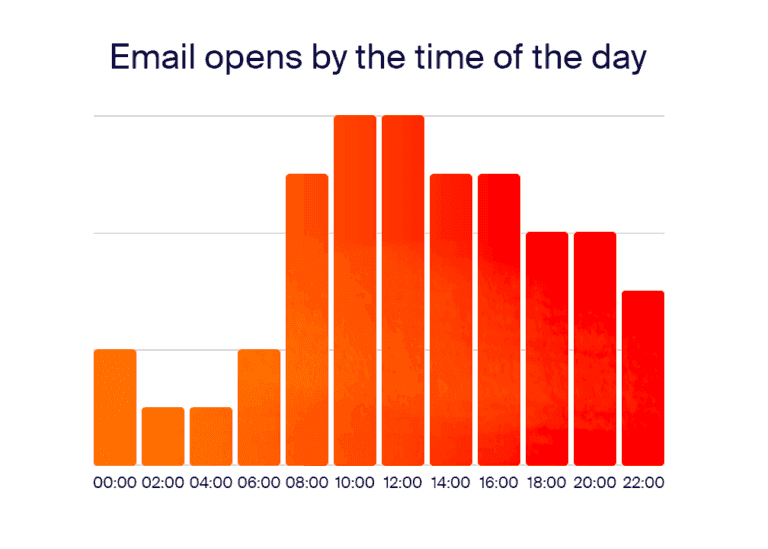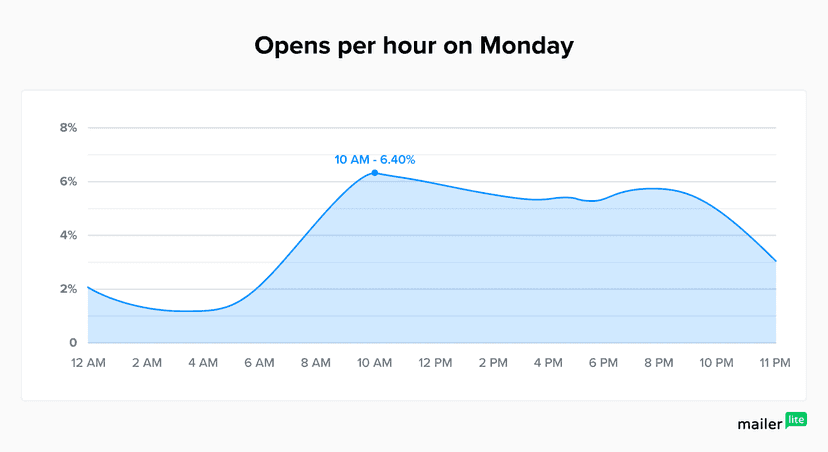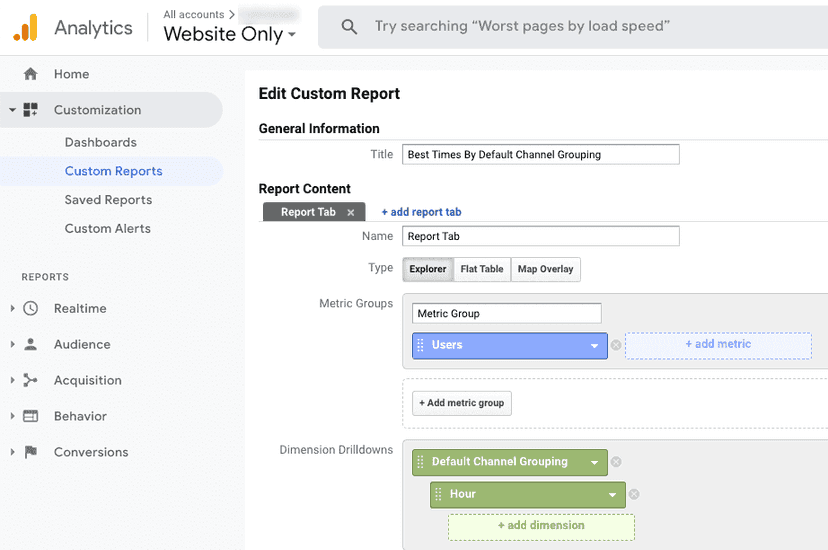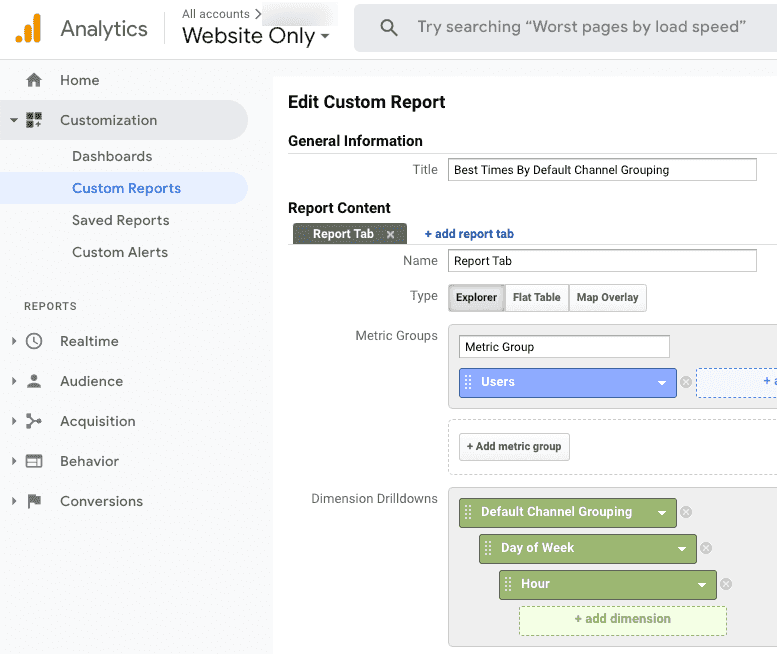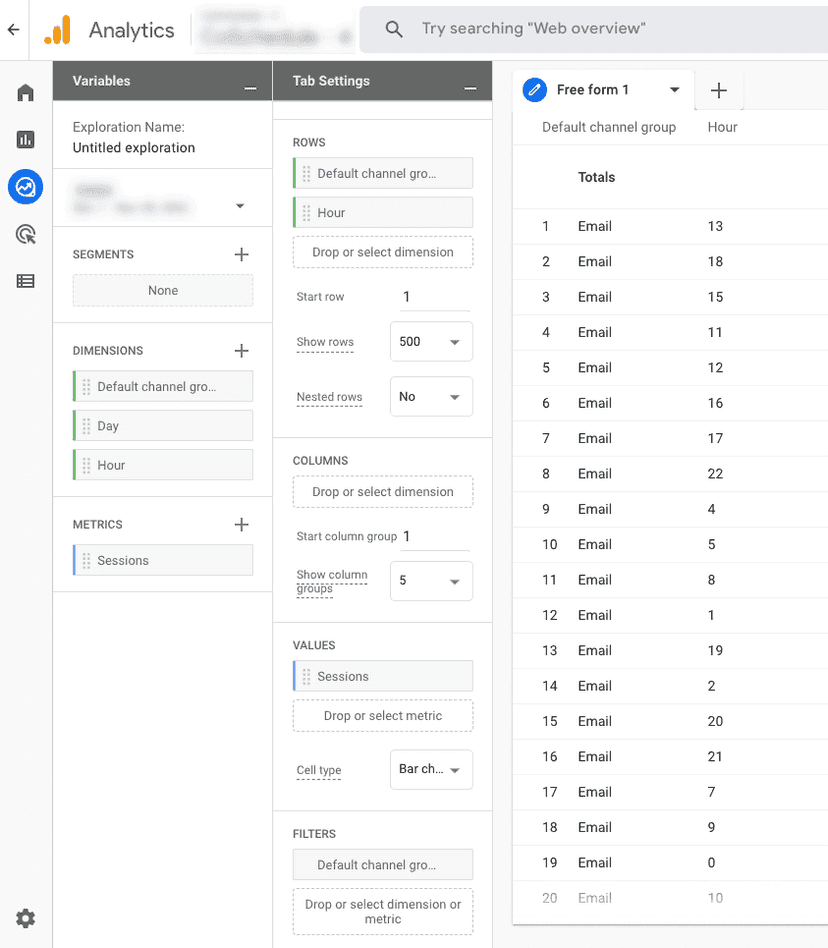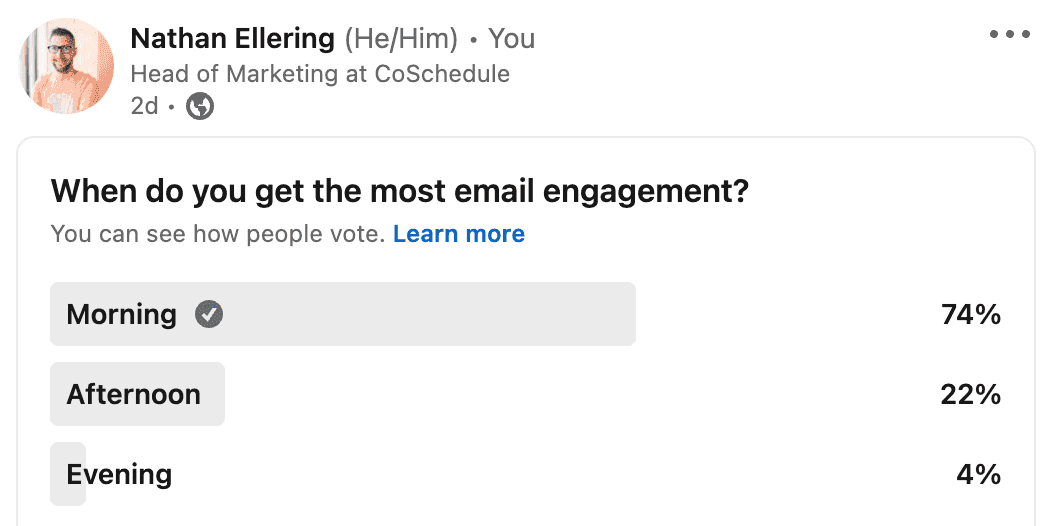When is the best time to send emails?
There is plenty of research on the topic. The problem is the original and proprietary research from email service providers only applies to their own user bases.
That’s where this piece differs from the rest. Read on if you want to know the trends from 10 data-driven studies published in the 202Xs to help you send emails at the best times.
Collectively, this resource provides insight from billions of email sends to help you cut through the clutter and find relevant, actionable data.
Here are the 10 proprietary research studies we analyzed to dissect the following findings:
- Sendinblue’s user data study (original research) from 2022
- GetResponse’s email marketing benchmarks report (original research) from 2022
- Omnisend’s best time to send emails research (original research) from 2022
- HubSpot’s best time to send an email user research report (original research) from 2022
- Salesforce Marketing Cloud’s customer research for email send time optimization (original research) from 2022
- Moosend’s best time to send email analysis (original research) from 2022
- CampaignMonitor’s email marketing benchmarks report (original research) from 2021
- Sender’s best time to send email report (original research) from 2021
- MailerLite’s best time to send email report (original research) from 2021
- Mailjet’s best time to send email newsletter data (original research) from 2020
What Is The Best Day To Send Email In 2024?
According to these studies, Thursday, Tuesday, and Wednesday are the best days to send emails.
- Thursday: This is the #1 best day to send emails, according to most of the data from these studies. Thursday ranked #1 best day in four of 10 studies and #2 in one other.
- Tuesday: If you send two emails a week, choose Tuesday for your second day. Tuesday ranked first in three of the studies and second in four of the studies.
- Wednesday: Wednesday is the third best day to send emails. Wednesday took first place in one study and second in three more.
Collectively, Thursday, Tuesday, and Wednesday took first place as the best days to send emails in eight of the 10 studies.
Best Days of the Week to Send Email in 2024 Ranked Best to Worst
- Thursday
- Tuesday
- Wednesday
- Monday
- Friday
- Saturday
- Sunday
In 2016, the best days to send emails were Tuesday, Thursday, and Wednesday. That’s according to similar compiled research we conducted more than seven years ago. It appears Thursday has gained traction in recent years.
In this dataset, we define “best” based mainly on open rates because that is what the 10 studies primarily analyzed.
Note: Apple iOS privacy changes rolled out between September and November 2021 allow Apple Mail users to choose whether they share data with marketers. When users decide to leverage these privacy settings, Apple automatically opens all emails on iOS devices and via Apple Mail. In 2022, Apple Mail held an estimated email client market share of 57.72%. With this privacy option available to its users, it’s possible that some open rate data isn’t entirely accurate.
This compiled study relies on aggregated data from email marketing platforms. Therefore, for this research piece, we analyzed the data available to us, trusting that these businesses cleaned the data before publishing it for the world to leverage.
The data you have is better than the data you don’t.
As Michal Leszczynski, Head of Content Marketing & Partnerships at GetResponse, notes on this subject, “Keeping this all in mind, it’s a bit too soon to say whether Apple’s iOS changes are making a noticeable impact. They’re definitely something you have to keep in mind when building your email marketing strategy – especially if other mailbox providers decide to make similar changes – so consider updating your automated campaigns or segmentations based on email engagement in the near future.”
What Is The Worst Day To Send Email?
Saturday and Sunday are the worst days to send email. Sunday is the biggest loser.
Saturday took sixth place in five of 10 studies and seventh place in four of 10 studies. Sunday took sixth place in four of 10 studies and seventh place in five of 10 studies. Therefore, according to this data, emails sent on Saturdays are more likely to perform better than emails sent on Sundays.
I’ll note: Some of the studies mentioned high opens and clickthrough rates on Saturdays and Sundays. Well, those are also the days when the fewest emails are sent. So while the open rates may be higher in general, the actual number of emails opened is way lower.
When Is The Best Time To Send Email In 2024?
The top five best times to send email are 10 a.m., 9 a.m., 8 a.m., 1 p.m., and 3 p.m.
- 10 a.m.: While morning send times are the best performers in general, 10 a.m. took first place as the absolute best time in four of 10 studies.
- 9 a.m.: This is another morning send time, collectively ranking in the top five places in six of the 10 studies.
- 8 a.m.: As with the two higher performing times, it appears that people may check email when they begin their workdays.
- 1 p.m.: It’s possible that people check email right after lunch. This was a popular time to get email opens.
- 3 p.m.: You might be successful by sending your emails later in the day as people check out of work mode and look for distractions.
In 2016, the best times to send email were 10 a.m., 8 p.m.-midnight, 2 p.m., and 6 a.m.
Note: A lot of these studies mentioned time zones. The big takeaway is to choose the time zone for most of your audience. If you’re in the U.S., that’s likely Eastern Time since that time zone covers roughly 50% of the population. If you’re a local company, send at these times in your own time zone.
Alternatively, many email marketing platforms now offer AI for send time optimization. This functionality aims to help you deliver emails to the right person at the right time. If that sounds interesting, providers like Sendinblue, Salesforce Marketing Cloud, and Mailerlite offer send time optimization features.
What Is The Worst Time To Send Email?
The worst times to send emails are 7 p.m.-2 a.m. None of the studies reported high engagement rates during the evening and early morning.
This data contradicts information from 2016 that suggested 8 p.m.-midnight was a good period to send email.
A Caveat On The “Best Times & Days” To Send Email
I found this quip from Robert Rose very insightful:
You may differentiate your emails by sending at the times and on the days when others don’t. Could off-peak hours work for you? Testing is the only way to find out.
What Are The Best Times To Send Emails By Day Of The Week?
We were curious to discover if the best times were specific to the days of the week. For example, is the best time and day to send emails on Thursdays at 10 a.m.?
Unfortunately, none of the analyzed studies offered any information to answer this question. The closest information we could find was from Mailerlite’s study, which concluded that 10 a.m. is the best time to send email every day of the week.
However, based on our analysis, if you were to test email send times and days, this is a suggestion we pulled together based on best practices to help you ship, measure, learn, and iterate:
- Thursday at 10 a.m.
- Tuesday at 9 a.m.
- Wednesday at 8 a.m.
- Monday at 1 p.m.
- Friday at 3 p.m.
- Thursday at 9 a.m.
- Tuesday at 10 a.m.
- Wednesday at 1 p.m.
- Monday at 3 p.m.
- Friday at 1 a.m.
Best Days To Send Emails: Visual Data From The Studies
Only some studies included visual representations of the data, but you’ll find it interesting to see the similarity among the graphs that were present. Notably, most activity happens during the middle of the week with only minor outliers. Here’s that data:
Sendinblue’s study suggests, “Across industries, emails sent on Tuesday and Thursday accounted for the greatest share of opens.”
GetResponse’s Michal Leszczynski finds, “[E]mail engagement is usually quite stable throughout the day and goes in-line with the typical business hours,” and “[T]here’s little difference in terms of engagement between individual weekdays.”
Omnisend’s research suggests, “The best days to send email are Tuesday for high open rates, Friday for high conversions.”
Marilia Dimitriou writes for Moosend, “Thursday was the best of the weekdays in terms of the highest open rate. Tuesday was the second-best day. Saturday had the lowest average open rate.”
CampaignMonitor’s data suggests, “When looking at email statistics by day, there doesn’t seem to be too much variance in how emails perform on a given day. Overall, weekdays — as usual — tend to perform the best, with the lowest engagement numbers falling on the weekend.”
Data from Sender finds, “It is best to send out email newsletters on Tuesday, Wednesday, or Thursday.”
Mailerlite’s data confirms, “Wednesday is the weekday with the highest open rate, closely followed by Monday.”
Research from Mailjet suggests, “Tuesdays through Thursdays have the highest open rates.”
Best Times To Send Emails: Visual Data From The Studies
Sendinblue notes, “Across industries, there are two best times to send an email: 10:00 AM and 3:30 PM.”
Michal Leszczynski from GetResponse notes, “[T]he best-performing hours are usually somewhere in the early morning.”
Bernard Meyer, Director of Content at Omnisend, suggests, “Research on the best time to send email campaigns based on the time shows that 8 am, 1 pm, 4 pm, and 3 am have the best open rates.”
As Kayla Carmichael writes for HubSpot, “We surveyed over 300 U.S. email marketers and found the majority reported the highest engagement for their marketing emails occurred between 9 AM to 12 PM and 12 PM to 3 PM.”
Annie Zhang wrote about Salesforce Marketing Cloud’s research, suggesting, “With respect to Central time (CT), mornings (especially 8 am ~ 10 am) consistently have higher number of opens compared to other times of the day, and weekdays tend to have more opens than weekends.”
Moosend’s study finds, “8-9 am was the best time of the day to deliver them. After 6 pm open rates started to decline.”
Sender’s data also finds, “The peak time for sending email blasts, as it becomes apparent, is between 10 and 12 in the morning. This is when most people start feeling the need to take that mid-afternoon break and check their inboxes.”
Mailerlite’s study was the only one we found that attempted to break down the best times to send emails every day of the week. Not surprisingly, their data suggests sending emails at 10 a.m. any day of the week performs the best. Every graph appeared similar to the one pictured here.
The Controversy Behind What You Just Read
Every one of the studies cites that the best time to send emails depends on your audience.
Here’s an older yet memorable quote from Megan at Wordstream: “That’s the advice. Now ignore it.”
If that’s true, why do so many studies offer similar information suggesting that sending emails on Thursdays at 10 a.m. will be the most successful?
Furthermore, there may be differences between different businesses with different audiences. Here’s a comparison chart of four different verticals from Sendinblue:
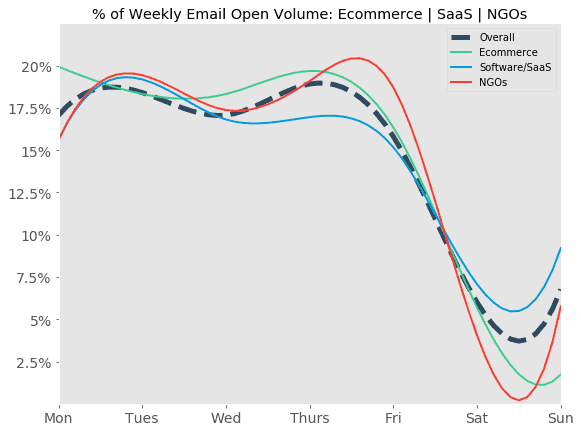
a href=”https://www.brevo.com/blog/best-time-to-send-email/?tap_a=30591-fb13f0&tap_s=806054-5ac44f” target=”_blank”>Source
Still, it does make sense to use these days and times to start a test for your own audience. As Marilia from Moosend notes, “Well, while the results are accurate, you should also consider another thing: your industry.”
And that’s why you can use your own data and Google Analytics to help you send emails more effectively.
Test & Measure Your Own Best Times To Send Emails
There are two phases to understanding the best times to send emails to your audience:
- Send emails at the best times you just learned from this piece.
- Analyze the data from your tests to see when you received the most traffic.
It’s really simple if you plan your work, then work your plan.
Plan To Test The Best Days & Times With Your Audience
Follow this outline to test your days and times to send email. Regardless of how many emails you send during a week, you can walk through this process from the first email to the last email over the time frame that works best for you.
It’s like a checklist for the days and times you’ll send your next 10 emails:

That is now your plan for the next 10 emails you’ll send to your subscribers.
We suggest a best practice to schedule your email to send at least a few minutes after the start of the hour. This way, your email will be at the top of your subscribers’ inboxes compared to other marketers who send their emails right on the hour.
Measure Your Email Test’s Success
What you’re looking to understand is how much traffic your emails contribute to your website. After all, these are your most loyal readers who read, share, and bring additional traffic to your site.
So while you could go into your email service provider’s dashboard to look at your open and clickthrough rates, an easier way to gauge the performance of your test is by using Google Analytics and reviewing your referral traffic from email.
In Google Analytics Universal, you may build your own Custom Report to understand when you earn the most traffic from email.
In Google Analytics Universal, Navigate to Customization > Custom Reports. Choose Metric Groups as Users. In Dimension Drilldowns, choose Default Channel Grouping, then Hour.
When you Save, you will then be able to click Email in the Custom Report to view Users by Hour from the Default Channel Grouping of Email.
For example, the best time to send email at CoSchedule is at 7 a.m., 10 a.m., 8 a.m., 9 a.m., and 3 p.m. Is it a coincidence that we get the most visitors at four of the best times to send email?
Alternatively, with Google Analytics Universal, you may see your best days to send emails with the best times. Build a Custom Report by navigating to Customization > Custom Reports. Choose Metric Groups as Users. In Dimension Drilldowns, choose Default Channel Grouping > Day of Week > Hour.
After you Save, select Email. You will see Day of Week as numbers with Sunday as 1, Monday as 2, and so forth. Select any Day of Week number to see a line graph of the best-performing hours on which you receive Users from Email.
For example, on Thursday (the best day to send email), CoSchedule’s best time to send email is 10 a.m. (which is also the best time to send email). In second place is 9 a.m. (the second best time to send email). In third place is 8 a.m. (the third best time to send email). Is this coincidence? Probably not.
In Google Analytics 4, you may create an Exploration to understand when you receive traffic from Email as a Session default channel.
In Google Analytics 4, navigate to Explorations and Start a new exploration from Blank; Create a new exploration.
In Dimensions, Import Default channel group, Day, and Hour. In Metrics, Import Sessions. Drag the Default channel group and Hour Dimensions to Rows. Drag the Sessions Metric to Values. The Exploration will be a table. Now you may Filter to ‘Default channel group exactly matches Email.’ Customize the date range to a whole month, like November. Now you’ll see your own best times to send email to influence Sessions.
5 Subject Line Tips To Get More Email Engagement
It’s no secret that your email subject line is one of the primary drivers of opens. It’s the part that usually stands out the most in your subscribers’ inboxes right from the get-go, making your first impression for the content you’re sending.
If opens lead to clickthroughs, and opens come from awesome email subject lines, let’s explore a few data-driven ways to write those subject lines so they help you reach your goal of getting more traffic.
Start with the free Email Subject Line Tester tool by CoSchedule!
1. Use Your Headlines For Inspiration
A while back, we analyzed more than 1 million headlines and found that how-to, list, and question headlines get more social shares than any other type of blog title.
The research for email subject lines suggests that these same three types of messaging perform really well for getting opens.
Email subject line examples:
- How To Make {Subject} That Will {Benefit}
- 21+ Ways To Grow Your {Subject}
- Do You Think You Can {Benefit}?
Bonus Tip: Write engaging headlines with the free Headline Analyzer tool by CoSchedule.
2. Your Subscribers Want To Know What’s In It For Them
There’s an old adage that helps marketers get into the heads of their audience: What’s in it for me? Judging from the data, answering that question in your email subject line is a fantastic way to increase your open rate.
Email subject line examples:
- 5 Reasons Why You Should {Subject}
- {Benefit} While You Sleep
- 10 Best {Subject} + [Template]
3. Show Who They Could Be Like After They Open Your Email
Social proof helps your subscribers see themselves as successful—which works incredibly well when they see others rocking your solution. So use your email subject line to appeal to the benefits of stories, case studies, examples, and testimonials.
Email subject line examples:
- How {Name/Company} does {Subject}
- {Name/Company} can afford any {Subject}, he uses {Solution}
- How {Name/Company} Got {Number/Desirable Outcome} In {Number Of Days}
4. Make It Unique To Stand Out In A Cluttered Inbox
A lot of successful email subject line examples suggest that uniqueness gets opens. Think of including jokes, humor, or something unexpected in your subject line—anything that arouses curiosity beyond the same-old, same-old.
Email subject line examples:
- real {audience} use {solution}
- Discover the {solution}
- {Subject}, {subject}, and {unrelated subject}?
5. Make Them Move Fast
The fear of missing out is a powerful motivator because it gets your subscribers thinking, “What do they know that I don’t?” Showing a deadline, appealing to a sense of urgency, or even suggesting scarcity in your email subject line can help you increase your opens.
Email subject line examples:
- Stop {Undesirable Current State} Now
- Copy and paste these {subject} [Last Chance]
- Discover the {solution} that will change your life today
Best Time To Send Emails FAQs
Is It Better To Send Email In The Evening Or Morning?
Data-driven and anecdotal research suggest sending emails in the morning provides the best results for opens and clicks.
Here is data from a LinkedIn poll CoSchedule conducted:
Is It Unprofessional To Email At 7 p.m.?
No, it is not unprofessional to send emails at 7 p.m., but it is not a good time for it to be opened, especially for B2B. 7 p.m. is one of the worst times to send an email. A better time to send professional emails is 10 a.m. in the receiver’s time zone.
What Time Should You Not Send An Email?
The worst times to send emails are 7 p.m.-2 a.m.
When To Send Emails In 2024?
The best day to send emails in 2024 is Thursday, and the best time is 10 a.m.
This post was originally published on March 23, 2016. It was most updated and republished on September 24, 2018. It was most recently reanalyzed and optimized in January 2023.

